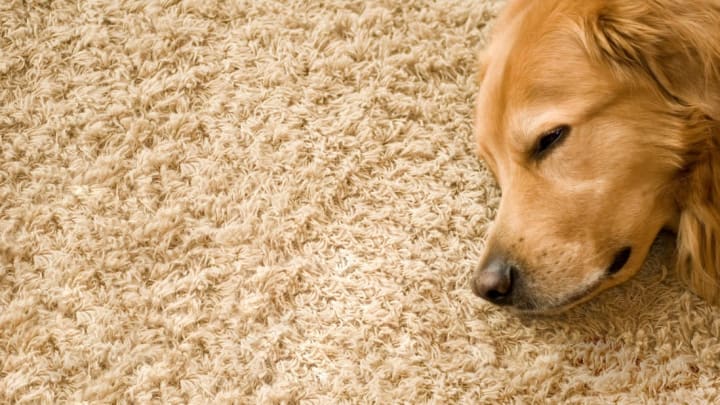The joys of pet ownership are many. Your furry pal can provide companionship, comfort, and might even be beneficial for your overall health.
But not every Instagram-ready dog or cat is mindful of house rules. Among their worst infractions: Ripping and tearing at carpeting.
Fortunately, there’s a fix, and it doesn’t require a call to a flooring store. The Washington Post columnist Jeanne Huber suggests first cutting out the damaged area so it’s in the shape of something easy to match, like a square or rectangle. (You can use a utility or a carpet knife.) Make sure to cut using a straight edge and to follow the fibers so that you’re cutting in between them.
Then, using the damaged piece as a template, take a carpet remnant and trim it to fit the new space. Cut it from underneath. Use one-sided carpet-seam tape to surround the hole, with part underneath the old carpet and part sticking out so it’s underneath the new piece. Then secure it in place, making sure the fibers “flow” in the same direction. Don’t use double-sided tape, as you don’t want to stick the piece to the floor. It should “float,” like the rest of the carpet does.
Seaming tape can be either pressure-activated or heat-activated to produce a strong bond. If you opt for heat-activated tape, which is stronger, you’ll need a special carpet iron to apply heat. You can also use a standard clothing iron with a damp towel as a buffer to swipe over the surface for about 60 seconds, moving carefully the entire time. If you find this tricky—too much heat might melt the carpet fibers, and possibly your entire home if you’re not careful—opt for the pressure-activated tape.
Naturally, you may wonder why anyone expects you to have an extra carpet remnant. Ideally, you might have some left over from the initial carpet installation, even if you weren’t in the home at the time. Extra flooring, roofing shingles, and the like can often be found in garages, attics, or basements.
If not, you can try to source a remnant from a carpet dealer if you know the product name or number. Be aware if you try to make a visual match, it may not quite work.
If you can’t find one, you do have another option—sourcing a “donor” carpet piece from somewhere it won’t be missed in your house, like a closet. If all else fails, you can hire a carpet care professional, who might be able to source a match from distributors. If you opt for this method—it might set you back $150—make sure to glare at your dog the entire time. Or consider floating vinyl flooring.
Above all else, make sure your pet is discouraged from attacking your carpet again. Cats should have scratching posts, so they won’t feel an urge to dig into the carpet tufts. If your cat scratches in the exact same spot, try moving a piece of furniture over it. Dogs—particularly puppies—can be dissuaded from chewing carpet by being told "no" and then immediately giving them with a chew toy (that's, ideally, not the carpet professional).
[h/t The Washington Post]
